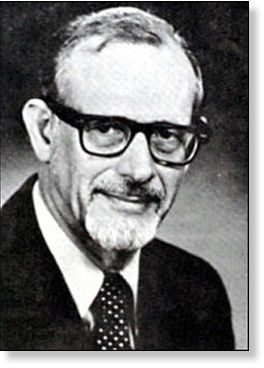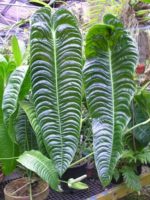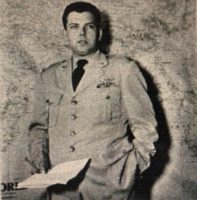by Charles Lear
 Some are born to it, some achieve it, and some have it thrust upon them. If one is talking about a life devoted to UFO research, Leonard Stringfield was in the last category. He was a prominent figure in the early days of UFO investigation and remained highly active until his death in 1994. Most notably, Stringfield was the only private investigator ever to have a direct line to the Air Force during their Project Blue Book investigation.
Some are born to it, some achieve it, and some have it thrust upon them. If one is talking about a life devoted to UFO research, Leonard Stringfield was in the last category. He was a prominent figure in the early days of UFO investigation and remained highly active until his death in 1994. Most notably, Stringfield was the only private investigator ever to have a direct line to the Air Force during their Project Blue Book investigation.
Born in 1920, Stringfield’s interest in UFOs began in 1945, just three days before the end of World War II. He was an Army Air Force intelligence officer, flying as a passenger in a C-46 headed for Iwo Jima. Mid-way, after taking off from Ie Shima, the plane developed a problem in its left engine and started losing altitude. As this was happening, Stringfield noticed “three unidentifiable blobs of brilliant white light, each about the size of a dime held at arm’s length.” The pilot regained control and as the plane ascended, Stringfield noted that the objects remained below and vanished into the clouds.
Writing about the incident in his 1957 book, “Saucer Post…3-0 Blue” he compared what he’d seen to the “foo fighters” reported by pilots from all sides of the war. He went on to write that he believed that the engine trouble had been caused by the objects.
In 1950, news reports of flying saucers revived Stringfield’s wartime memory. One report was from a family that had seen an object fly over their house that lit up the area under it as it passed. The other was of a blue light swinging like a pendulum over a ridge. The witnesses were fellow citizens of Cincinnati, Ohio and Stringfield was impressed by their “genuineness.” He became convinced that flying saucers were interplanetary and found this “ominous.” In 1952, there was a flap that included sightings in restricted airspace over Washington, D.C. during two consecutive weekends. On July 25th, Stringfield and other Cincinnatians observed a teardrop-shaped object moving quickly through the sky and changing direction. He was compelled to report it to the press and announce that he was forming a research group, the Civilian Investigating Group for Aerial Phenomena. Though the organization consisted only of Stringfield throughout its short, less than 2-year existence, he received hundreds of reports and was noted as a local flying saucer authority.
 In 1954, Stringfield was corresponding with an investigator in Illinois, Bill Culmer. They discussed the need for a group that not only investigated, but put out a regular bulletin. Though Culmer died that year, Stringfield went on to form Civilian Research, Interplanetary Flying Objects. At this point, flying saucers were beginning to take over his life at the expense of his other pursuits. An avid botanist with a greenhouse, Stringfield became aware to the extent of his obsession when a prized plant, an Anthurium veitchii, died of neglect. Things got out of control when radio announcer and flying saucer champion, Frank Edwards, urged his 10,000,000 listeners to write to Stringfield’s P.O. Box in order to receive CRIFO’s newsletter. The next day, he recieved a huge stack of mail and enlisted his wife and two young daughters, aged four and six, to help him process over 6000 requests. The bulletin was called, Orbit and was published until 1957.
In 1954, Stringfield was corresponding with an investigator in Illinois, Bill Culmer. They discussed the need for a group that not only investigated, but put out a regular bulletin. Though Culmer died that year, Stringfield went on to form Civilian Research, Interplanetary Flying Objects. At this point, flying saucers were beginning to take over his life at the expense of his other pursuits. An avid botanist with a greenhouse, Stringfield became aware to the extent of his obsession when a prized plant, an Anthurium veitchii, died of neglect. Things got out of control when radio announcer and flying saucer champion, Frank Edwards, urged his 10,000,000 listeners to write to Stringfield’s P.O. Box in order to receive CRIFO’s newsletter. The next day, he recieved a huge stack of mail and enlisted his wife and two young daughters, aged four and six, to help him process over 6000 requests. The bulletin was called, Orbit and was published until 1957.
CRIFO quickly became a well-known organization and the Air Force took notice. Air Defense Command in Columbus, Ohio contacted him and told him they wanted to make use of his network in order to receive sightings reports as quickly as possible. They also told him they were going to instruct the southwestern Ohio Ground Observer Corps to report all unidentified sightings directly to him. They gave him a clear line to ADC with the number, Foxtrot, Kilo, 3-0 Blue. A friend in the GOC later told Stringfield that, if one of his reports was confirmed by radar, a jet would be scrambled to intercept and the incident would become classified.
 His arrangement with the Air Force put Stringfield in a unique position. He was almost an insider. His perspective was somewhere between that of former Project Blue Book head Captain Edward J. Ruppelt, and National Investigations Committee on Aerial Phenomena director Donald Keyhoe. Ruppelt wrote the 1956 book, “The Report on Unidentified Flying Objects” and Keyhoe the 1950 book, “The Flying Saucers Are Real” and in combination with Stringfield’s book, they provide a broad view of the Air Force’s relationship with the public when it came to UFOs.
His arrangement with the Air Force put Stringfield in a unique position. He was almost an insider. His perspective was somewhere between that of former Project Blue Book head Captain Edward J. Ruppelt, and National Investigations Committee on Aerial Phenomena director Donald Keyhoe. Ruppelt wrote the 1956 book, “The Report on Unidentified Flying Objects” and Keyhoe the 1950 book, “The Flying Saucers Are Real” and in combination with Stringfield’s book, they provide a broad view of the Air Force’s relationship with the public when it came to UFOs.
As Stringfield collected reports and investigated, he noted that the press seemed hesitant to publish some of the more significant cases he presented to them. He suspected there was some sort of official censorship at work and looked into the matter. What he found was that, while there was no direct action by officials to squash reporting, there seemed to be an agreement among editors to downplay certain incidents. His instincts were accurate as many researchers now know after the revelation that the C.I.A. had concluded that the public’s excitement over UFOs constituted a threat to national security. This was after years of monitoring the Air Force’s investigation, organizing their own investigation and forming an advisory panel known as “The Robertson Panel” which met in 1953 and was named after its chairman, physicist Howard P. Robertson.
Stringfield’s association with the ADC ended in 1956 when the GOC was disbanded. He wrote that he received a letter from Director of Air Force Intelligence General John A. Stamford, thanking him for his service. He continued investigations with CRIFO until 1957 and looked into some fascinating cases. One case involved a Cincinnati man, Edward Mootz, who reported that while tending to his peach tree, an upside down pear-shaped, red and green object with a fin, dropped a red liquid on him. He said it “felt like phosphorous” burning into his skin and he ran into his house where he removed his clothes and washed it off. When he returned to the peach tree, he found it was shriveled and dead. He showed Stringfield “white pinprick scars” where his arms had been burned and gave him peaches that had been “pruned.” Stringfield wrote that the Mootz peach pit would not sprout when tested in a lab, whereas a pit from an equally dried peach prepared by the lab did.
Stringfield formed relationships with many prominent researchers of the day including Lex Mebane and Ted Bloecher of C.S.I. of NY, James Moseley, and Donald Keyhoe. Upon disbanding CRIFO, Stringfield joined up with Keyhoe and served as NICAP’s public relations advisor until 1972. He would go on to be active in other groups. He was director of public relations and a board member for Mutual UFO Network and a regional investigator for J. Allen Hynek’s group, the Center for UFO Studies. He assisted the Condon Committee by collecting regional UFO reports for them and, in 1978, served as an advisor to Grenada Prime Minister Sir Eric Gairy, who was working to establish a UFO research group within the United Nations.
In the 1970’s, Stringfield became particularly interested in reports of UFO crashes and retrievals. He collected reports and gave his first presentation on the subject at a 1978 MUFON Symposium. He went on to publish seven “Status Reports” until his death in 1994. In addition to the Status Reports, he published a book, “Situation Red!” in 1970.
In 2012, MUFON acquired Stringfield’s research papers. His work amounted to 60 volumes, which is a testament to his devotion. This writer wonders if his Anthurium veitchii would have been honored to have died for such a cause.